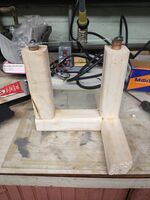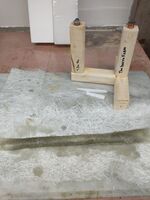Difference between revisions of "Foam Cutter"
(→Images) |
(→Images) |
||
| Line 18: | Line 18: | ||
<gallery widths=300px heights=200px> | <gallery widths=300px heights=200px> | ||
File:Styrofoam burner prototype.jpg|Please excuse the misalignment of the copper cut tubings. They were simply pieces from my excess bolts and screws pile. | File:Styrofoam burner prototype.jpg|Please excuse the misalignment of the copper cut tubings. They were simply pieces from my excess bolts and screws pile. | ||
| − | File:Styrofoam burner prototype 2.jpg| | + | File:Styrofoam burner prototype 2.jpg|Basic cylinder test. A piece of Styrofoam from Michaels (pictured in the back) was cut to a small size lengthwise, and then rolled with glass and coated with 8040. |
</gallery> | </gallery> | ||
Revision as of 21:30, 6 February 2024
It's easy to make a foam cutter out of only Nichrome resistance wire and an Adjustable Power Supply. Foam cutters are documented well online, and you will find no shortage of videos and articles available. Here is my approach.
Items Needed
- Nichrome / Resistance Wire
- Voltage source, Ideally an Adjustable Power Supply
- Frame to hold the wire
Details of Items
Wire
When buying the Nichrome wire, you are dealing with fairly small wire. You don't want to buy wire that is too thick, as there will be no resistance, and the wire will just short your PSU. On the other hand you don't want to buy wire that is too thin, as it will be more likely to break. I bought 30 feet of 28 Gauge wire on ebay, and it was about $7 delivered. This turned out to be a good size, and I guessed correctly when purchasing for the first time. But I'm also a bit of a wire collector, so I had some insight as to what would and wouldn't work. Experience with magnet wire will help here. It's possible to purchase Nichrome wire from official channels, as well if you are worried about quality (general Industrial distributors such as Mcmaster, or the electronics distributors, Mouser, Farnell's, Digikey). It's easy to find online. It's also very cheap. If you keep wire in inventory, there's no reason not to have some Nichrome wire. You may also be able to salvage it from hair dryers or portable heaters (from what I've read).
Power Supply
For the Power Supply, It's best to start with an Adjustable Power Supply, set the current to 1A or so, and then ramp up the voltage to where the wire just starts to cut through the styrofoam. I found with my PSU that with the 28 gauge wire of about half a foot, that 3V was all that was needed to get the wire to easily cut through the foam. There's no need to get the wire to be red hot or anything dramatic. It should at a voltage just slightly above where it is a bit hot to the touch through a latex or nitrile glove. If you only have a 3.3V or 5V PSU, you are running things a little more dangerously, though it will likely be OK. So a 5V Power Brick of say 1A will probably work in a pinch. However, Variable Voltage Supplies can be found for <$50 and any type of lab or workshop should have one. I purchased mine for $30 from a local electronics surplus store.
Frame
For the frame, I quickly glued together some non-conductive wood and then just screwed down some washers over a piece of cut copper tubing. The wire is wrapped around the screw, and the washers have it make conduct. The leads from the PSU connect to the copper tubing. It's extremely basic, but also extremely quick to make! This is just a proof of concept, and is not meant to be anything for production. It's just to demonstrate the viability of Nichrome wire to melt styrofoam.

